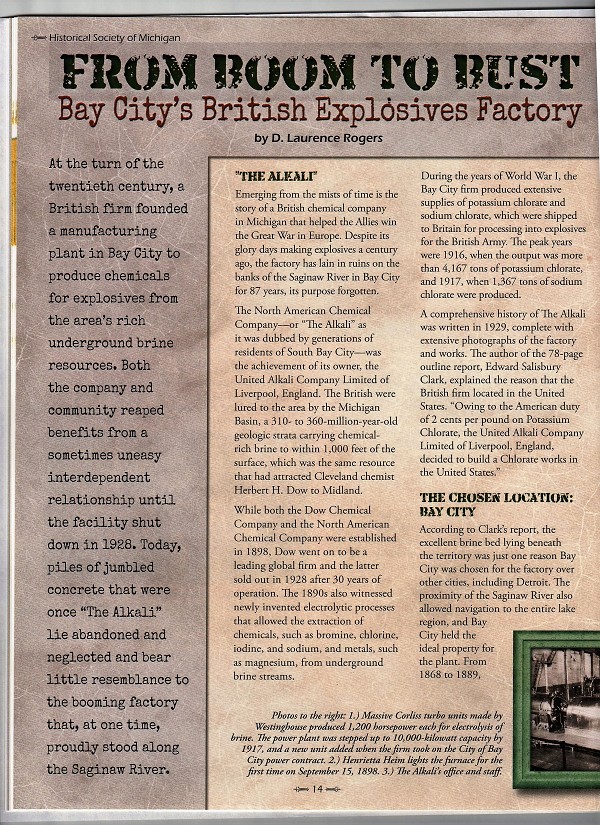
EXPLOSIVE TALE: State History Magazine Features Bay City Alkali Site
Lost 86 Years, North American Chemical Fame Finally Emerges
November 15, 2015
By: Dave Rogers
Sometimes history is very elusive.
That's why the publication of the story of Bay City's British-owned North American Chemical Company by the Chronicle of the Historical Society of Michigan in its recent issue is so important.
Perhaps the mysterious aspects of the firm, and the reasons for its demise, will attract added scrutiny, perhaps by academics, and answer some of the intriguing questions that have been lingering for decades.
How big the contribution of Bay City's North American Chemical Company to the British Army in World War I is not calculable -- only the raw statistics of the chemicals on which explosives were based are available.
The full record of the firm, including statistics on its chemical output by year, are in my latest book, "Mysteries of Skull Island & the Alkali," published by Historical Press (989-686-5544), available by sending $15 per book to Historical Press L.L.C., 4659 Dale Ct., Bay City, MI 48706.
Let's just say the long-forgotten factory on the Saginaw River was a "major source" for British explosives, and leave the estimations of impact to the mathematicians and militarists.
We do know finally know the story of the massive factory, built in 1898 at a cost of $1.25 million, (estimated $31 million today), a story that went into the dustbin of history in 1929 when the plant was demolished.
The only reason we have the background, and photographs, of the plant, on which my book is based, is that the secretary of the firm, attorney Edward Salisbury Clark, wrote a 78-page outline report including dozens of excellent photos of the plant, and donated it to the Bay County Library System. There it sat on a back shelf gathering dust for 86 years, until reference librarian Mary Macmanmon, now retired, pointed it out to me a couple of years ago.
Edward Salisbury Clark is an untold story himself: born in New York in 1871 to the Rev. William Hendee Clark and Lucy Whitman Hoisington Clark, he was graduated from the University of Pennsylvania in 1893. How he became affiliated with the United Alkali Co., Ltd., of Liverpool, England, is not known, but the connection seems to have brought him to Bay City five years after graduation.
Several years after his arrival, his father, who had been pastor of Dutch Reformed Churches in New York and Philadelphia, came here as pastor of First (Presbyterian) Church.
By one account, Clark married Amy Alice Luckham, a Canadian. Another says he married Lucy Tyson Ballou in Bay City in 1895. He spent his entire 30-year career here, retiring when the North American Chemical Company was purchased and closed in 1928. He was a member of the prestigious Bay City Club and the Bay City Whist Club. He and his wife (whoever she was) had a daughter, Lucy, and a son, Edward S. Clark, Jr., also an attorney. Clark Sr. lived at 414 N. Monroe and later at 2221 Center Avenue. He practiced law with the firm of Clark & Henry and died in 1966.
But nagging questions remain about the British firm he served so long and documented so ably.
The firm that employed 200-300 at its peak, was not a major competitor to The Dow Chemical Company, or was it? It did make a variety of chemicals, including copious amounts of alcohol from sugar beet residue.
By furnishing electric power to the City of Bay City, North American was in the same business as the Consumers Power Company that acquired it in 1928.
Eliminating the competition by buying them out was nothing new in business, so the purchase by Consumers was understandable. Consumers fulfilled the city contract on favorable terms and by all accounts was a good citizen in that regard.
But the fact is that a foreign chemical firm operating 20 miles from a domestic company, and was no doubt somewhat of a threat as a business competitor, was thereby exorcised.
Would North American have gone on to grow to a chemical giant employing thousands, perhaps even hundreds of thousands like Dow?
And why did no successor firm move in and utilize the numerous brine wells that drew from the same underground chemical source as Dow?
Of course we'll never know. But the thought is tantalizing nonetheless. Isn't it?
We'd love to hear any ideas or information you might have on the subject.
###

